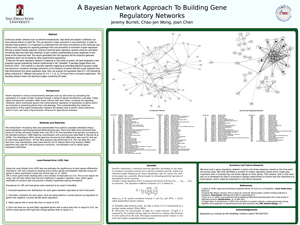 |
||||||||
 |
 |
 |
 |
 |
| A Dynamic Bayesian Network Approach to Building a Gene Regulatory Network of Plants Undergoing Cold Stress | ||
|
Continuous abiotic stresses (such as extreme
temperatures,
high winds and edaphic conditions) can have adverse effects on
plant life. This can become a major constraint in crop
production. In order to alleviate the problems, it is
important to understand the cold stress mechanisms at the
molecular and cellular levels, regarding the signaling
pathways from cold perception to activation of gene
expression. My mentor, Dr. Joan Chen, and her lab, together
with other labs, have collected a large amount of DNA
microarray data involving plants undergoing cold stresses. I
took a system biology approach, aiming to build the gene
regulatory network using the cold stress microarray data that
have been obtained, to gain a better understanding of plant
responses to cold stress at the molecular level. The results
generated from this approach will be utilized to generate
hypothesis which can be tested by other experimental
approaches.
| ||
|
The Dynamic Bayesian Network (DBN) method was
chosen to build the transcription regulatory network. This work
will show an implementation of Dynamic Bayesian Network (DBN) method
and use of the R package, GeneNet, to build a gene regulatory network,
which can be easily interpreted by bench scientists.
|
||
| • Other Abstracts • | ||
